|
This website originally published at www.bellsystemleadpoisoning.com and republished with kind permission on www.lead.org.au
|
| This web site's intended audience includes all former and retired Bell System employees who had occupational exposure to lead, especially during the 1940s and early 1950s, their families, descendants, and other interested parties. Because lead poisoning can demonstrate protean and subtle manifestations that may elude detection completely, or erroneously be attributed to other causes, there may be Bell System employees who, along with their families, unknowingly experienced lead poisoning. For those individuals the ingestion or inhalation of lead may have resulted in life-long disabilities, disabilities that nobody ever thought to link to lead poisoning. |
| A guide to researching a family tree for evidence of previously unrecognized lead poisoning in family members
This guide is intended as an aid for the reader trying to determine if they or a family member (perhaps now deceased) unknowingly experienced lead poisoning from lead supplied by the Bell System.
|
|
How lead-safety was addressed (or not addressed) in 11 Bell System safety manuals issued between 1922 and 1974 (*) (**)
The eleven safety manuals were issued by various Bell System companies for use by employees, many of whom had occupational exposure to lead. Together the manuals cover the period from about 1922 to 1974, and together they hint at the diversity of attitudes toward lead-safety within the Bell System at the time.
Three of the manuals, one from 1943 and two from 1946, document the changes in occupational lead-safety at one Western Electric factory. The 1943 manual devotes a total of 14 words to lead-safety and only addresses hand washing. The other two manuals, one published in June and the other in August 1946, each devote about 125 words to the topic of lead-safety. Between the two manuals they address hand washing, fingernail cleaning, showering, respirator use, prohibitions against eating or chewing tobacco while working with lead, warning against swallowing even small quantities of lead or allowing lead to simply come in contact with the skin, warnings about inhaling lead dust, and an admonition to use gloves while working with lead. The two manuals while not identical in content address lead-safety in much the same way. Between 1942 and 1946 both the American Public Health Association and the Michigan Department of Labor and Industry issued public warnings about the rising danger of lead poisoning in industry. These warnings may have partly explained the stepped-up awareness of lead-safety in the 1946 manuals, an increase in awareness that is evident when these two manuals are compared to the 1943 manual.
The other eight manuals controlled safety operations outside the factory for six Bell regional operating companies plus Western Electric, Bell Canada, and AT&T Long Lines respectively. The eight safety manuals are as follows.
| Bell company |
Publication date |
Comment (if any) |
| Western Electric |
1927; rev. 1930 |
- |
| Bell of Penn. And Diamond State Tel. |
1922; rev. 1941 |
- |
| Bell of New England |
1943; various sections rev. through 1962 |
- |
| Mountain States Tel. |
1922; various sections rev. through 1957 |
- |
| C. & P. Tel. & Tel. Co |
1974 |
- |
| Pacific Bell |
1945; various sections rev. through 1949 |
- |
| The Bell Tel. Co. of Canada |
1922; various sections rev. through the early �50s. |
See note on p.71 of PDF copy |
| AT&T Long Lines |
1923;various sections rev. through the early �50s. |
(see footnote) (***) |
The Western Electric manual, issued to field employees at a time when many telephone switching centers, still under construction, had yet to go into service and therefore remained under the control of Western Electric, devotes 37 words to the topic of lead-safety. It states only that employees should not touch their nose, eyes, or mouth with hands contaminated with lead. The other seven manuals devote ZERO content to lead-safety even though operations that required the handling of lead-covered cable and solder are addressed in all seven. Solder had been identified as a potential source of lead poisoning as early as 1922 by the U.S Department of Labor (****). A section of the Bell Canada safety manual is particularly helpful in that it cross-references entries in the safety code with entries in Bell System Practices (BSP) that dealt with safety. The cross-reference shows that neither the code nor BSP discussed lead-safety either directly or indirectly via discussions concerning the safe handling of solder and cable.
The original owner of the New England Telephone safety manual, a 30-year Western Electric employee, reports that this was the manual he was required to study. This hints at the possibility that as more and more telephone switching centers came online - resulting in work shifting from job sites controlled by Western Electric to job sites controlled by the local operating companies - Western Electric field employees would have been required to follow the safety guidelines of whatever local operating company they were performing services for at the time. This would have been in place of guidelines established by Western Electric itself. This had a certain logic to it. If a Western Electric field employee was injured on the job while engaged in work on local operating company premises, there could not have been a debate as to which safety code that individual should have followed. The downside to this change, however, was that control over the safety of some 24,000 + (in 1942) Western Electric field employees would have been lost to Western Electric's corporate safety managers. Since there were over 20 different operating companies plus Bell Canada, each completely autonomous within its own territory and each with its own unique understanding of lead-safety (or lack thereof in the case of the 6 regional operating companies listed in the table above along with Bell Canada and AT&T Long Lines) this meant that for the group as a whole there was theoretically any one of over 20 different safety codes that could have been followed. It also meant that the hard-learned lessons on lead-safety made by Western Electric's manufacturing division probably failed to disseminate to Western Electric employees working in the field, because to disseminate would have meant sidestepping the authority of managers in other Bell System companies, a potential provocation that Western Electric management might not have been willing to risk.
(*) PDF copies of the manuals can be found on the "Scanned Document Library" page of this website.
(**) The System used lead to sheath telephone cables and as an alloyed component of solder.
(***) AT&T Long Lines installed and maintained the equipment needed to make long distance telephone calls.
(****) Bulletin # 306, "Occupational Hazards and Diagnostic Signs", Bureau of Labor Statistics (BLS), U.S. Dept. of Labor, April 1922. The dangers of occupational lead exposure, including those of exposure to lead solder, are also addressed extensively in BLS Bulletin # 95, July 1911. Copies of these bulletins may be found in libraries, the archives of the BLS.
|
|
A word about the 1941 Bell Telephone Company of Pennsylvania/Diamond State Telephone Company �Safety Practices� manual. When the manual arrived in the mail it was noted that its stiffened naugahyde cover was quite soiled. The cover was tested with a LeadCheck TM swab. When applied to a surface contaminated with lead the LeadCheck TM solution will turn the swab pink to red. The manufacturer states that any pink color indicates the presence of lead with a high degree of accuracy and that roughly speaking the darker the color the higher the lead level. The results of the test are shown in the photographs to the right.
When the cover was first tested the swab came back almost black with just a hint of a pink/red color beneath a layer of grime. However after the swab was gently rinsed in a stream of cold municipal tap water the grime was washed away revealing the color seen in the photos. Similar results were seen following the testing of one of the Western Electric factory safety manuals. The covers look ordinary and harmless�but they�re not.
|
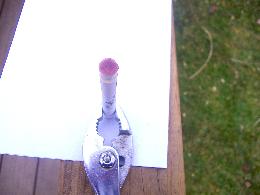 |
| click to enlarge |
|
|
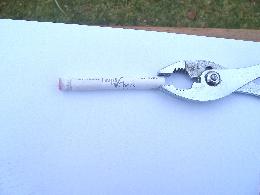 |
| click to enlarge |
|
|
|
Bell System Management acknowledged the dangers of uncontrolled occupational lead exposure
In December 1979, more than eighty years after the Bell System first began using lead in quantity 1, System Management finally acknowledged for the first time that uncontrolled occupational lead exposure was dangerous. This new found knowledge almost arrived too late, for a scant 4 years later in 1984 federal regulators succeeded in dismantling the Bell System.
Read Management�s acknowledgement of the lead hazard as it was published in Bell System Practices 620-100-010 �Occupational Exposure to Lead � Cable Removal� 2. This document can be found on the "Scanned Document Library" page of this website.
1 Beginning around 1895 and continuing for the next several decades the Bell System ultimately consumed hundreds of thousands of tons of lead.
2 �Bell System Practices� (frequently abbreviated �BSP� followed by a volume and section number) was a System-wide set of published standards and procedures that covered every imaginable work situation in the Bell System.
|
| 75 Bell System employees participated in a national health survey that included a determination of blood lead levels in 50% of participating adults. |
| Lead-safety for today's telecommunications workers. |
|
Anyone the least bit familiar with fiberoptic networks knows that little if any lead is used in their construction. That doesn't mean that today's telecommunications technician can't come into contact with lead in the telephone workplace however. Old lead-covered telephone cable [1] and even lead-soldered circuits still exist in some places and handling lead, especially for extended periods, is still a hazard. In the absence of clear direction from your company's safety department here are dos and don'ts when handling lead.
|
|
[1] A report of an in-depth study of the history and environmental impact of lead-sheathed power and telephone buried cable "Environmental Impacts of Lead from Paper-Insulated Lead-Covered Cable". The study was completed and published in 2004 under the sponsorship of the Electric Power Research Institute, Palo Alto, CA. Alternatively a PDF copy of the report can be obtained by sending an email request to The LEAD group Inc.
|
| Archival material on the health threat to consumers and workers from the use of lead by the telecommunications industry. |
| Uncovering a sixty year-old story of lead poisoning |
This is the story of how lead supplied by the Western Electric Co., a unit of the Bell System, surreptitiously poisoned a Company worker and his family, or so the author believes. It is also the story of what the Company should have done to protect its exposed, non-factory workers from the hazards of lead, and what it did not do, and why this case of poisoning went undetected for more than 5 decades. The successor to Western Electric, Lucent Technologies, Inc., has via a spokesperson refused to grant access to records that could either refute or support the allegation that Western Electric failed to adequately protect a group of its workers.
(additional search terms: illness, disease, health, working conditions, history of the Bell System, Bell System history, phone company, telephone company, Western Electric, Western Electric installer, Western Electric retirees, Bell System, Bell Telephone, Bell System retirees, Bell Telephone retirees, Bell System workforce, telephone company retirees, Lucent, Lucent retirees, NHANES II, solder, industrial lead exposure, industrial lead poisoning, occupational lead exposure, occupational lead poisoning, occupational lead safety, industrial lead safety, telecommunications workers, lead safety, dangers of solder)
An investigation of circumstances surrounding an alleged case of lead poisoning
|
| Because of a critical shortage of tin during the 1940s the amount of lead in solder increased to as much as 97%.*
This in turn led to an increase in the number of cases of lead poisoning.
|
|
By mid-1944 the tin shortage, the result of a Japanese embargo and merely inconvenient in 1941, was becoming serious if not critical. To the maximum extent possible tin was being taken out of solder and replaced, chiefly with lead but also on occasion with small amounts of cadmium, bismuth, and antimony. Cadmium in particular is extremely toxic. The U.S. government contracted with the National Academy of Sciences to study various low-tin and tin-free alloys in order to determine their suitability for use as solder in different industrial applications. A wide variety of types of solder were tried by many different industries and companies, including the Bell System, to find the right combination of cost, utility, and ease of application. The authors strongly suggest that the Bell System finally settled on a rosin-core solder containing approximately 78% lead, 20% tin, 1.2% silver, and 1.5% antimony. (**)
* Solder with 97% lead was often used in the aircraft industry. See National Academy of Sciences " The Advisory Committee on Metals and Minerals - Metals and Minerals Conservation and Substitution Group, Report No. 10, 1941".
** See table 3, solder # 4, PDF page 42; and PDF page 43, paragraph 3, in the "Final Report on Investigation of Industrial Uses of Tin-Free and Low-Tin Solder: Part III".
|
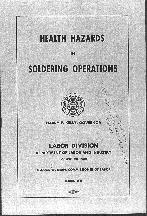 |
| click to enlarge |
|
|
| As more and more companies used greater and greater amounts of lead to satisfy the needs of war-time manufacturing, the number of cases of poisoning following occupational lead exposure increased. The American Public Health Association (APHA) and the State of Michigan Department of Labor and Industry (DLI) issued separate warnings to industry, first in 1942 (APHA), then again in 1943 (APHA), and finally in 1945 (DLI), pointing out the dangerous trend and offering advice on ways of controlling it. The authors of this pamphlet (cover shown above) allude to an upsurge in the number of cases of lead poisoning due to the high lead content of war-time solder. Solder was used by Detroit vehicle manufacturers for body work, manufacturing radiators, and for securing electrical connections. Due to the tin shortage solder for body work approached a lead content of 100%. The authors also noted that �where large numbers of [soldering] irons are used in the same area or where housekeeping is not good, we have found as high as 3.2 milligrams of lead per 10 cubic meters of air [where 1.5 milligrams is the highest acceptable level]....[while in an area where a large number of soldering irons were being cleaned], we found 17.3 milligrams of lead per 10 cubic meters of air.� |
| Bell System solderers were at risk from lead oxide.
A simple experiment shows how quickly lead oxide can form on the surface of solid 70/30 rosin-core solder (from the roll pictured on this web site). Read about the experiment and then view a short video clip that shows the ease with which lead oxide can transfer from lead solder to bare skin.
|
|
Extremely hazardous Bell System lead solder is being sold on Internet auction sites!
|
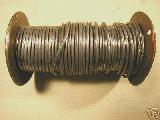 |
| click to enlarge |
|
|
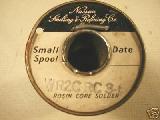 |
| click to enlarge |
|
|
|
(refer to the lefthand picture, above) Bell System solder found to contain 70% lead. A thin film of lead oxide coats the solder and comes off easily in the hand. The solder was purchased on an Internet auction site. While a roll of lead-free solder can be purchased at any electronics store for a few dollars, old rolls of Bell System solder just like this one are selling at Internet auction sites for as much as $140 a roll and higher. This could be by design. High prices keep the solder out of the hands of casual uninformed users such as young teenagers. Such persons would probably be completely unaware that the solder contained dangerous amounts of lead.
(refer to the righthand picture, above) End view of roll of Bell System solder found to contain 70% lead (certificate of analysis is available). Naussau Smelting and Refining Co. was a Bell System company. The stamped alpha-numeric code is likely an engineering specification reference. Note the absence of a zip code or street address, plus the name "Nassau Smelting and Refining Co." instead of "Nassau Smelting and Refining Works, Ltd.". This together with the lead content places the time of manufacture for this roll sometime between the very late '30s and the early 1950s. Note also that the label fails to indicate that lead is present in the solder. "The presence of lead in commercial products is sometimes unknown to...the foreman or the workers", wrote the authors of Lead: Health Practices Pamphlet No. 3 in 1942, "because the label or description gives no indication that lead is present. As a result, employees may, through ignorance, be exposed to a serious lead hazard." (see National Safety Council entry on this website; quote is from paragraph 8 of the pamphlet; a copy of the pamphlet has been posted to the "Scanned Document Library" page of this website). Since Nassau Smelting and Refining was a Bell System company, this is yet another indication of a Bell System safety program with serious failings.
|
|
The National Safety Council and lead-safety in the Bell System
Bell System executives were active members of the Council at a time when many telephone company employees both in and out of manufacturing were daily being exposed to lead. 1
1 National Safety Council documents are posted to the "Scanned Document Library" page of this website
|
|
Leonard Woodcock, president of the United Auto Workers from 1970 to 1977, speaking on lead-safety in the American workplace
In April 1977 Leonard Woodcock appeared before the Occupational Safety and Health Administration, U.S. Department of Labor, to give comment on OSHA�s proposed standard on occupational exposure to lead. Although his views on safe lead levels are now out of date (not surprising after 30 years) most of his observations and insights are timeless and to the point. They could be applied not only to lead but to many workplace toxins and could serve as a blueprint and source of inspiration to anyone seeking a safe and healthy workplace.
The speech focuses on the need to reduce airborne lead levels, which is of course important. For many Bell System workers, however, hand-to-mouth exposure was as important or at times more important than airborne exposure. The reason for this is that work material containing lead was often handled bare-handed. In that case ready access to hand-washing facilities is of paramount importance.
Click below to read Leonard Woodcock's testimony
|
|
About Us
bell system lead poisoning
Contact Us
Council Lead Project
egroups
Library-Fact Sheets
Home Page
Media Releases
Newsletters
Q&A
Referral Lists
Reports
Site Map
Slide Shows-Films
Subscribe-Donate
Useful Links
Privacy Policy
|